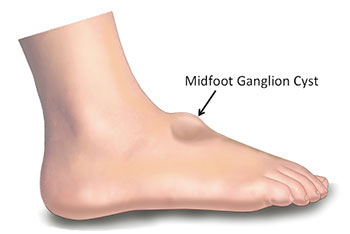Cysts

Ganglion Cyst
What is a Ganglion Cyst?
Ganglion cysts are the most common benign fluid filled masses which commonly occur on top of the foot. They typically form around tendons or joints. The word “ganglion” means knot which describes the mass or lump underneath the skin. Ganglion cysts vary in size and may temporarily disappear and return at a later time.
What causes a Ganglion Cyst?
A ganglion cyst is caused by repetitive trauma, which damages the soft tissue of a joint and the sheath that surrounds the tendon. As a result, the tissue becomes irritated and extra tissue forms. The existing fluid from the joint and tendon sheaths expands the extra tissue and a mass becomes visible under the skin.
Symptoms of a Ganglion Cyst
First the patient notices a lump directly underneath the skin and then there is typically difficulty wearing shoes due to pressure from the shoes. There can also be pain from pressure from local tissues such as a tendon or joint. If the cyst touches a nerve the patient can experience tingling or burning. The mass can be soft or hard to the touch and can grow slowly or quickly. If the fluid is removed from the cyst, the cyst will temporarily disappear and then refill later.
Diagnosis of a Ganglion Cyst
To diagnose a ganglion cyst, Dr. Fihman will perform an examination of the foot. The ganglion cyst is usually firm and cannot be mobilized over the underlying bones and joints; however the skin is freely moveable over the cyst. The physician will shine a light through the cyst or remove a small amount of fluid from the cyst for analysis by pathology. X-rays will be taken to evaluate any underlying bone damage. Additional imaging such as MRI may be ordered.
Treatment of a Ganglion Cyst
- Conservative Treatment
If the cyst is not painful and the patient can function normally then Dr. Fihman may decide to just monitor the cyst over a period of time. If shoes are a factor, then it is advised to modify shoewear that prevents rubbing or irritation from the cyst. Placing a pad in the shoe may also help reduce the pressure. The least aggressive treatment is called aspiration and this is performed in the office. First the area is numbed with local anesthetic and then a needle is used to remove the fluid from the cyst. The fluid is sent to a lab for an analysis. After, a corticosteroid is injected to reduce the chance of a recurrence. This is a fairly simple procedure; however there is a high recurrence rate.
- Surgical Treatment
The gold standard and the chance of very low recurrence rate is when the cyst is surgically removed. The cyst as well as all the damaged tissue is removed. The patient can walk right after surgery in a special shoe and can resume regular activity in a few weeks after the skin has healed.
